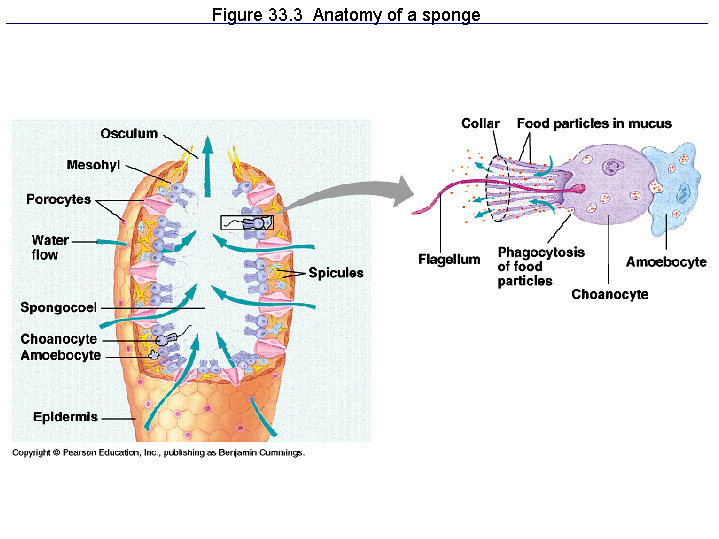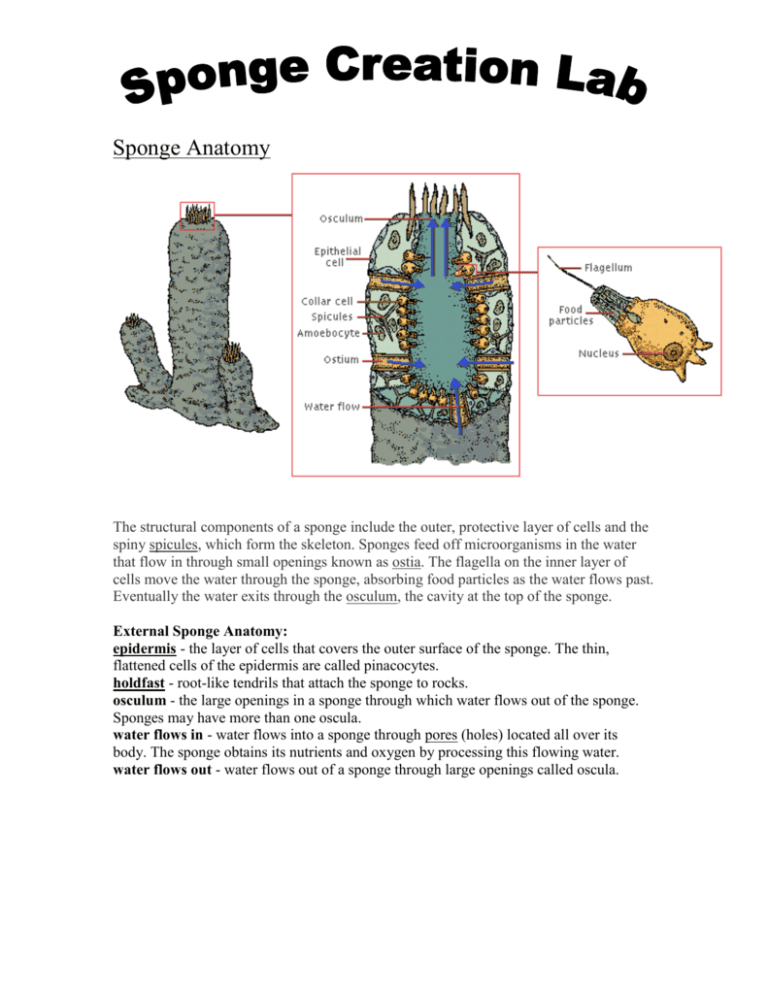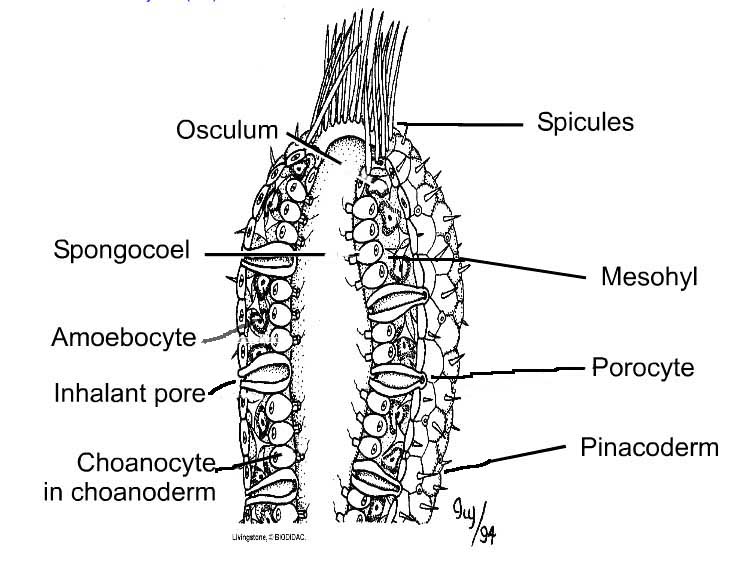Describe the Anatomy of a Sponge
What does the arrow in the middle represent. Since sponges do not have real tissues or organs therefore they have no digestive system such as that of more complex living things their only.

Modern Sponge Anatomy A Schematic Cross Section Of Simple Asconoid Download Scientific Diagram
Contrast the way of life of a sponge with that of a cnidarian.

. The middle mesohyl layer consists of gelatinous proteincarbohydrate material a range of mobile cells and a skeleton of calcareous or siliceous spicules or of elastic. As the most ancient extant metazoans glass sponges Hexactinellida have attracted recent attention in the areas of molecular evolution and the evolution of conduction systems but they are also interesting because of their unique histology. The outer sac layer consists of flattened polygonal cells called pinacocytes.
Based on your explanations what would you expect to be thicker and heavier. Sponges are found in a wide variety of colors shapes and sizes and scientists believe that the colors of the sponge may act as a protection from the suns harmful UV rays. In male anatomy the corpus spongiosum of penis is a mass of erectile tissue that lies along the underside of the penis and is located below the pair of corpus cavernosa which contain 90 percent.
Sponges are generally sessile as adults and spend their lives attached to a fixed substratum. They are the most numerous animals on Earth. Describe and draw the basic anatomy of a sponge including.
Simple sponges with choanocytes lining inner cavity radially symmetrical Syconoid Condition Choanoderm and Pinacoderm folding creates the shape. Sponges contain no organs or even tissue. Describe the anatomy and life cycle of sponges and cnidarians.
Describe three main characteristics of sponges. In asconoid sponges the two major cell layers surround a fluid-filled cavity called the spongocoel the large central cavity of sponges. Under experimental conditions researchers have shown that sponge.
In the gel layer are either spicules supportive needles made of calcium carbonate or spongin fibers a flexible skeletal material made from protein. Sponges are aquatic invertebrates. Compressed polygonal cells called pinacocytes make up the pinacoderm the external sac layer.
Describe the anatomy and life cycle of sponges andcnidarians. They have been around for approximately 750 million years. This drawing shows the internal anatomy of a sponge.
The body of a sponge has two outer layers separated by an acellularhaving no cells gel layer called View the full answer. The arm bones of a weightlifter or the arm bones of a jogger. The sponge is made up of two single-cell-deep layers and an intermediate mesohyl mobile cells plus extracellular matrix.
In male anatomy the corpus. Sponges are unusual animals in that they lack definite organs to carry out their various functions. They make up the phylum Porifera.
The body of a sponge has two outer layers separated by an acellular having no cells gel layer called the mesohyl also called the mesenchyme. Invertebrates are animals without a backbone. It consists of a cell mass in the form of a sac through which the water circulates in which is the oxygen that allows it to breathe and the food with which it subsists.
Contrastingly what effect does sedentarism weightlessness in space or in bedridden patients. Name an invertebrate. Water is pumped directly through pores called ostia into the spongocoel and then out of the sponge through an opening called the osculum plural oscula.
The most important structure is the system of canals and chambers called a water-current system through which water circulates to bring food and oxygen to the sponge. Sponges are animals with dense skeletons that are highly adapted to their environments although it is easy to see why they may be mistaken for plants. Sponge Structure and Function Sponges have three different body plans of sponges and use flagellated cells to pull seawater into their bodies to obtain particles of food.
The sponge is made up of two single-cell-deep layers and an intermediate mesohyl mobile cells plus extracellular matrix. Ostia oscula choanocytes amoebocytes spicules Ostia small incurrent pores Oscula large excurrent pores. Sponges are members of the Phylum Porifera meaning pore-bearing and are the oldest of all multi-cellular animals.
Sponges have specialized cells and an. However sponge cells are capable of creeping along substrata via organizational plasticity ie rearranging their cells. Sponges belong to phylum Porifera and are asymmetrical sessile and non-moving.
Choanocytes in small chambers called choanocyte chambers original much that open to an apopyle leading to the spongocoel. Explain how cnidarians are more anatomically complex than sponges. Identify the basic morphology of a hydra.
A the direction of the sponges travel through the water B the flow of water through the body of a sponge C the path sperm take to fertilize the egg of a sponge D the path food takes through the digestive system of a sponge. Describe the specific changes seen in the microscopic anatomy of the sponge bone in response to exercise. They do not show movement over large distances like other free-swimming marine invertebrates.
Instead they consist of three cell sized layers. The greater part of their soft tissue consists of a single multinucleate syncytium that ramifies throughout the sponge. They lack true tissues but have many cell types that take on these functions.
The water-current system also helps disperse gametes and larvae and remove wastes. The cells in the outer. Sponges are exclusively aquatic filter feeders that actively pump water through their bodies to eat breathe and excrete.
Up to 24 cash back Basic Anatomy. The body of a sponge has two outer layers separated by an acellular having no cells gel layer called the mesohyl also called the mesenchyme. Feeding Sponges Responds to its anatomical structure which is quite simple.

Porifera Circulatory System Study Com
Sea Sponges Characteristics Reproduction Uses And More

Sponge Structure And Function Advanced Ck 12 Foundation
Anatomy The Basics Of Porifera

Figure 33 3 Anatomy Of A Sponge

Chapter 33 Invertebrates Bi 212 Learning Objectives Flashcards Quizlet


Comments
Post a Comment